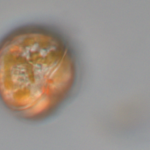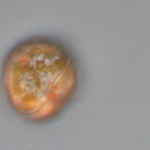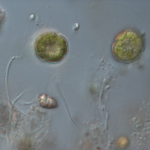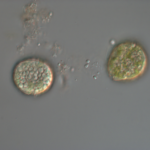Detected Species
-
HAB Species
- Diatoms
- Dinoflagellates
- Cyanobacteria
- Raphidophytes
- Haptophytes
-
Non-toxic Species
- Diatoms
- Dinoflagellates
Contact Us:
Mihaela D. Enache, Ph.D., Project Manager & Co-PI, Research Scientist I, Division of Science and Research, NJDEP (mihaela.enache@dep.nj.gov)
Ling Ren, Ph.D., PI, Research Assistant Professor, College of Science, George Mason University (lren2@gmu.edu)
Gymnodinium aureolum
Syn. Gyrodinium aureolum; Gymnodinium mikimotoi; Karenia mikimotoi
Morphology
Cells round, the body length range 18–30 µm and the width range 16– 28 µm. Cells slightly longer than wide. Cingulum usually median and relatively wide. There are several oval chloroplasts, each with a conspicuous pyrenoid. The nucleus is in the left side of the hypocone.
Toxins and toxicity
In New Zealand, G. cf. aureolum was found to produce lipid-soluble toxins and caused a toxic shellfish event and fish-kill. It can produce both hemolytic and ichthyotoxins. which caused damage to fish farms in northern Europe, Japan, and New Zealand.
Distribution and Occurrence
This dinoflagellate and its blooms have been detected in Europe (Britain, Denmark, France, Ireland, Norway, Germany, North Sea, Baltic Sea, and Black Sea), North America, Asia (China, Korea, and Japan), and Oceania (Steidinger 2018). In this study, this species was abundant in REF-1, PGD-1, and PGD-2 in March, July, and August.
References
Hallegraeff, G. M., D. M. Anderson, A. D. Cembella, and H. O. Enevoldsen. 2004. Manual on harmful marine microalgae, 2nd rev. ed. UNESCO.
Steidinger, K.A. & Meave del Castillo, M.E. [Eds.] 2018. Guide to the Identification of Harmful Microalgae in the Gulf of Mexico, Volume I: Taxonomy. St. Petersburg, FL, 384 pp. http://myfwc.com/research/redtide/research/scientific-products/
Hansen, G., Daugbjerg, N. & Henriksen, P. (2000). Comparative study of Gymnodinium mikimotoi and Gymnodinium aureolum comb. nov. (=Gyrodinium aureolum) based on morphology, pigment composition and molecular data. Journal of Phycology 36: 394-410




